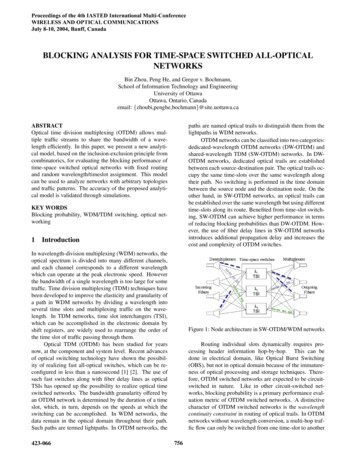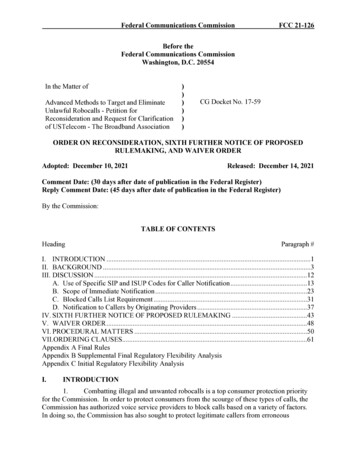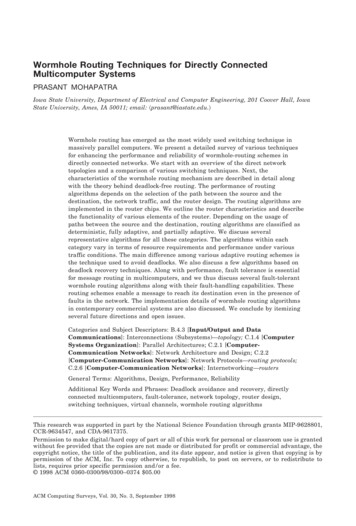
Transcription
BLOCKING ANALYSIS FOR TIME-SPACE SWITCHED ALL-OPTICALNETWORKSBin Zhou, Peng He, and Gregor v. Bochmann,School of Information Technology and EngineeringUniversity of OttawaOttawa, Ontario, Canadaemail: tical time division multiplexing (OTDM) allows multiple traffic streams to share the bandwidth of a wavelength efficiently. In this paper, we present a new analytical model, based on the inclusion-exclusion principle fromcombinatorics, for evaluating the blocking performance oftime-space switched optical networks with fixed routingand random wavelength/timeslot assignment. This modelcan be used to analyze networks with arbitrary topologiesand traffic patterns. The accuracy of the proposed analytical model is validated through simulations.paths are named optical trails to distinguish them from thelightpaths in WDM networks.OTDM networks can be classified into two categories:dedicated-wavelength OTDM networks (DW-OTDM) andshared-wavelength TDM (SW-OTDM) networks. In DWOTDM networks, dedicated optical trails are establishedbetween each source-destination pair. The optical trails occupy the same time-slots over the same wavelength alongtheir path. No switching is performed in the time domainbetween the source node and the destination node. On theother hand, in SW-OTDM networks, an optical trails canbe established over the same wavelength but using differenttime-slots along its route. Benefited from time-slot switching, SW-OTDM can achieve higher performance in termsof reducing blocking probabilities than DW-OTDM. However, the use of fiber delay lines in SW-OTDM networksintroduces additional propagation delay and increases thecost and complexity of OTDM switches.KEY WORDSBlocking probability, WDM/TDM switching, optical networking1IntroductionIn wavelength-division multiplexing (WDM) networks, theoptical spectrum is divided into many different channels,and each channel corresponds to a different wavelengthwhich can operate at the peak electronic speed. Howeverthe bandwidth of a single wavelength is too large for sometraffic. Time division multiplexing (TDM) techniques havebeen developed to improve the elasticity and granularity ofa path in WDM networks by dividing a wavelength intoseveral time slots and multiplexing traffic on the wavelength. In TDM networks, time slot interchangers (TSI),which can be accomplished in the electronic domain byshift registers, are widely used to rearrange the order ofthe time slot of traffic passing through them.Optical TDM (OTDM) has been studied for yearsnow, at the component and system level. Recent advancesof optical switching technology have shown the possibility of realizing fast all-optical switches, which can be reconfigured in less than a nanosecond [1] [2]. The use ofsuch fast switches along with fiber delay lines as opticalTSIs has opened up the possibility to realize optical timeswitched networks. The bandwidth granularity offered byan OTDM network is determined by the duration of a timeslot, which, in turn, depends on the speeds at which theswitching can be accomplished. In WDM networks, thedata remain in the optical domain throughout their path.Such paths are termed lightpaths. In OTDM networks, the423-066Figure 1: Node architecture in SW-OTDM/WDM networksRouting individual slots dynamically requires processing header information hop-by-hop. This can bedone in electrical domain, like Optical Burst Switching(OBS), but not in optical domain because of the immatureness of optical processing and storage techniques. Therefore, OTDM switched networks are expected to be circuitswitched in nature. Like in other circuit-switched networks, blocking probability is a primary performance evaluation metric of OTDM switched networks. A distinctivecharacter of OTDM switched networks is the wavelengthcontinuity constraint in routing of optical trails. In OTDMnetworks without wavelength conversion, a multi-hop traffic flow can only be switched from one time-slot to another756
within the same wavelength, as shown in Fig. 1.The problem of computing blocking probabilities forWDM networks under static routing with random wavelength allocation and with or without wavelength converters has been studied extensively in [3] [4] [5]. However, there is not much analytical work for OTDM networks. DW-OTDM networks are logically equivalent tosingle fiber WDM networks. Thus the previous analytical models for WDM networks can be used for analyzingDW-OTDM without any changes. It has been shown thatSW-OTDM networks are logically equivalent to WDM networks with multiple fibers on each link and no TDM [7].Unfortunately, the analytical models for multi-fiber WDMnetworks in the literature, including a recently publishedone [3], are complicated and not accurate. In [4], blockingperformance has been analyzed for one isolated multi-hoppath in single-fiber multi-wavelength TDM-switched networks. However, this model did not consider the contentionof bandwidth from other traffic requests. Therefore, it cannot capture the dynamic nature of network traffic and cannot accurately calculate the network-wide blocking probabilities.Future wide area networks are most likely to be alloptical OTDM/WDM networks with tens or hundreds ofnodes and tens of wavelengths/timeslots multiplexed oneach link. Because of high computational complexity, themodels in the current literature could not apply satisfactorily to the analysis of such large networks. Thus the objective of this work is two-fold. One is to develop a technique applicable to arbitrary topologies which is computationally tractable. The other is to give reasonable estimatesof blocking probabilities for design purposes and the analytical study of issues like benefits of TSI, wavelength conversion and so on.In this paper, a new analysis model is proposed forperformance evaluation of SW-OTDM/WDM networks.The DW-OTDM switched networks can be viewed as aspecial SW-OTDM switched networks, which only haveone time-slot per wavelength. Particularly, we investigatethe dimensioning issues of SW-OTDM switched networksthough studying the effect of TSI on network performance.The remainder of the paper is organized as follows: SectionII presents the analytical model of SW-OTDM networks.Section III discusses the performance results obtained using the analytical model. Section IV concludes the paper.2The same model is also used in [5]. The traffic model consists of a set of equations that determine the traffic offeredto each link at time-slot level according to the path blocking probabilities. On the other hand, due to the wavelengthcontinuity constraint, for multi-hop connection requests, anoptical trail has to use the same wavelength along its route.A multi-hop connection could be blocked even if there areidle time-slots on each link of the route but in differentwavelengths. Thus, the lightpath model consists of a set ofequations that determine the path-blocking probabilities according to the offered traffic on each link at the wavelengthlevel. The OTDM model converts traffic load from thetime-slot level to the wavelength level, and thus establishesa connection between the traffic model and the lightpathmodel. This leads to a set of coupled non-linear equationswhich must be solved to obtain the blocking probabilities.Iterative algorithms are designed to obtain the approximatesolutions in most analysis methods, including ours.2.1System Parameters and Assumptions1. The network consists of N nodes connected by J linksin an arbitrary fashion.2. Each link has the same B wavelengths, each wavelength consists of K time-slots, thus each link has afixed capacity of C time-slots, C K B.3. Calls for a node pair S arrive according to an independent stationary Poisson process with rate λs . Eachcall requires a full time-slot on each link of its path.4. The duration of each call is exponentially distributedwith a mean of one unit (1/µ 1).5. Traffic on one time-slot can only be switched onto another time-slot in the same wavelength.6. The wavelength and time-slot assigned to a route ischosen uniformly randomly from the set of idle wavelengths and time-slot. The assumption makes allwavelengths and time-slots identical and the analysistractable.7. We assume fixed routing. This means that each nodepair has exactly one pre-determined route.8. The state of a wavelength on link j is independent ofthe state of wavelengths on link j 1. In other words,the sets of idle/occupied wavelengths on links are independent. This is also called link-load independenceassumption.Analytical ModelTypically, in a network, the blocking probabilities of thepaths and arrival rates to a link are coupled to each otherby the fact that the blocking determines the traffic carriedby the network and the carried traffic in turn determinesthe blocking. Our analytical model consists of three parts:a traffic model, an OTDM model, and a lightpath model.The Traffic model assumes that the idle time-slot distribution on a link can be described by the state-dependent routing model first proposed by Kelly and developed in [6].2.2Traffic ModelDefinitions:XR The random variable representing the number of idletime-slots on route R.757
Xj The random variable representing the number of idletime-slots on link j.P r{βj b Xj N } 0 if (N b or N bK) BbK bN if ((b 1)K N bK)BKN BbKbN BKN b 1PB zBzK( 1)b zb zzNz max{1,K/N } BKNqj (m) The probability that exactly m time-slots are idleon link j.αj (m) Given exactly m idle time-slots on link j, the timeuntil the next call setup on j is exponentially distributed with parameter αj (m).Figure 2: Markov chain for the distribution of idle wavelengths on a fiberqj (m) Pr{Xj m}if (b N (b 1)K)(1)The number of idle time-slots on link j can be viewed asa birth-death process. The arriving and serving behavioron link j forms an M/M/C/C system and the correspondingMarkov chain is illustrated in Fig. 2. Since all the statesin the Markov chain are ergodic and hence, the equilibriumstate distribution of the chain can be derived as follows:qj (m) C(C 1).(C m 1)qj (0),αj (1)αj (2).αj (m)2.4XThe Lightpath ModelBR Blocking rate of calls on route RYi,j The random variable denoting the state of wavelengthi on link j. Yi,j 0 if wavelength i is idle on link j;Yi,j 1, otherwise.(2)γi,j The probability that a fixed set of i wavelengths is idleon link j.(3)giR The probability that a fixed set of i wavelengths is idleon route R.For 1-hop routes, the blocking probabilities can be obtained from:BR qj (0) βj (0)(6)λR Pr{XR 0 Xj m} f or m 1, ., C.The blocking probability of a multi-hop route R is theprobability that there is no wavelength (or time-slot) whichis idle on all the links used by R. We haveR:j R(4)2.3(5)Definitions:αj (m) is obtained by combining the contributions from therequest streams to routes which traverse j, as follows:αj (m) P r{βj b Xj N }P r{Xj N }N 1whereCXC(C 1).(C m 1) 1qj (0) [1 ] .αj (1)αj (2).αj (m)m 1CXβj (b) OTDM ModelBR P r{XR 0} 1 P r{XR 0}(7)Using inclusion-exclusion principle and the assumption ofrandom wavelength assignment, we haveDefinitions:βj The number of idle time-slots on link j.βj (b) The probability that exactly b wavelengths are idleon link j. A wavelength is idle if any of its time-slotsis idle.P r{XR 0} BXi 1( 1)i 1 Bi giR(8)Under the assumption of link-load-independency, theprobability that a fixed set of i wavelengths is idle on amulti-hop route R isYgiR γi,j ,(9)The conditional probability that b wavelengths areidle in link j under the condition that N time-slots are idlein link j can be obtained by using inclusive-and-exclusivetheory in combinations and permutations.j:j R758
whereγi,j P r{Y1,j 0, Y2,j 0, ., Yi,j 0}.probabilities. An iterative algorithm can be developed accordingly to find the solution by repeated substitution. Inpractice, the solutions converge in a few iterations for a variety of topologies. The method of iterative substitution isdescribed as follows:(10)From the assumption of link-load independency, we havethe following conditional probability of a fixed set of iwavelengths is idle on link j provided that there are a totalof b idle wavelengths on link j. bi (11)P r{Y1,j 0, ., Yi,j 0 βj b} BiAccording to the law of total probability, we have bBXi γi,j βj (b) Bb 1i1. For all routes R, initialize B̃R to zero.ForjP 1, ., J, initialize αj (0) 0 and αj (m) R:j R λR , m 1, ., C.2. Determine the idle capacity distribution of all linksqj (·), j 1, ., J, using equations (2) and (3).3. Calculate γi,j for all links, j 1, ., J and i 1, ., B using equation (12).4. Update αj (·) using equations (5) (8) and (15).(12)5. Calculate BR for all routes. If maxR BR B̃R then terminate. Otherwise, let B̃R BR and go to 2).Therefore, the state dependent blocking probability ofroute R can be obtained byP r{XR 0 βj b} BXi 1 ( 1)i 1Bi 2.7One of the main objective of this paper was to proposeanalytical models with reduced complexity to enable thestudy of large networks. The computational requirementof the proposed analytical model is O(N 2 JB 2 C). Thecomputational complexity of the technique presented in [3]is O(N 2 JCB C/B 2 ) for fixed routing, which limits itsapplicability to small networks. Although the proposedOTDM model is less complex than the multi-fiber model in[3], the OTDM model can achieve higher accuracy than themulti-fiber model, because in multi-fiber model the carriedlink-loads are approximated by offered link-loads, whichwould introduce large errors when traffic load is high.giR (Xj b),(13)where bYi .giR (βj b) γi,j Bj:j Ri (14)Given m idle time-slots on link j and the lightpathmodel, the equation (4) can also be defined as follows :αj (m) BX X3In this section we demonstrate the accuracy of our analytical techniques by comparing analytical results to simulation results. Simulation results are plotted along with 95%confidence intervals estimated by the method of replications. The number of replications is 30, with each simulation run lasting until each type of call has at least 100,000arrivals. For the analytical results, the iterative algorithmterminates when all blocking probability values have converged within 10 5 .(15)Analysis of a NetworkBased on the lightpath model, the network-wide blockingprobability can be obtained by the ratio of the total blockedload versus the total offered load, i.e.,N (NP 1)P Numerical ResultsP r(XR 0 βj b)P r{βj b Xj m}.R:j R b 12.5Computational Complexityλs P r{Xs 0}s 1N (NP 1).(16)λss 12.6Computation of blocking probabilityFrom the above analysis, a set of non-linear coupled equations has been obtained for the computation of blockingFigure 3: Network topologies759
Simulation experiments are conducted on the 14-nodeNSFNET and 19-node EON network topologies, which areshown in Fig.3. In the simulations, the call requests arriveto the network following a Poisson process, and the callholding time is exponentially distributed. We assume thatall the source-destination node pairs have the same trafficload in Erlang. Each fiber link has fixed capacity (32 timeslots channels). Simulations are conducted with differentwavelength-timeslot combinations of the same link capacity: 2-wavelength-16-timeslot, 4-wavelength-8-timeslot, 8wavelength-4-timeslot, and 16-wavelength-2-timeslot. Wedefine the time-slot-wavelength ratio (TSWR) as the ratioof number of time-slots per wavelength over total numberof wavelengths per link. Fixed shortest path routing is usedto calculate the shortest path (in hop-counts) for each nodepair. The granularity of a call connection is a optical-trail,which occupies one time-slot on each link along the route.be observed that the network-wide blocking probabilitiesincrease as the network load becomes heavier. Given thesame link capacity, it can also be observed that it decreasesas TSWR increases. However, the performance gains resulting from the increase of TSWR cannot be improvedfurther once the number of time-slots per wavelength increases above a certain value for both networks.The switches with higher TSWR are required to operate at higher space switching speed. For example, theswitching speed of a 2-wavelength-16-timeslot switch hasto be 4 times higher than that of an 8-wavelength-4-timeslotswitch in order to achieve the same link capacity. On theother hand, the switches with lower TSWR require largernumber of transmitters and receivers although each of themcan work at lower speed. For example, a 2-wavelength-16timeslot switch needs only one fourth the transmitters andreceivers compared to an 8-wavelength-4-timeslot switchthat has the same capacity.Figure 4: Analysis results of network-wide blocking probability versus network load for EON networkFigure 6: Comparison of numerical results for EON networkFigure 5: Analysis results of network-wide blocking probability versus network load for NSFNET networkFigure 7: Comparison of numerical results for NSF networkFig. 4 and Fig. 5 demonstrate the numerical resultsobtained from the proposed analytical models for the EONnetwork and the NFSNET network, respectively. It canFig. 6 and Fig. 7 compare the numerical results obtained from the analytical models to those from simulation760
experiments for the EON and the NSFNET networks, respectively. The numerical results of EON conform closelyto the simulation results. However, for the NSFNET topology, there are noticeable difference between analytical results and simulation results. This can be explained bythe assumption of link-load independency in this analytical model. For networks with low node-degree and lowTSWR, the link-load independency model cannot accurately capture the wavelength usage in the network. As indicated in [5], the link-load independency assumption canbe adapted to a link-load correlation assumption, thus amore accurate estimation of the blocking probabilities canbe obtained but with higher computational complexity.4[6] S. Chung, A. Kasper and K. Ross, “Computing Approximate Blocking Probabilities for Large Loss Networks with State-DependentRouting,”IEEE/ACMTransactions on Networking , 1(2), 1993, 105–115.[7] N. Wauters and P. Demeester, “Wavelength Translationin Optical Multi-wavelength Multi-fiber Transport Networks,” Int’l J. of Opto-electronics, 11(1), 1997, 53–70.ConclusionAn analytical model has been developed for evaluating the blocking performance of all-optical time-spaceswitch WDM networks. The analytical model can also beused to study performance of multi-fiber WDM networkswith/without limited-range/full wavelength conversion because of the logical equivalence of these networks. Using the analytical model, the network-wide blocking probability is derived from the traffic model, the OTDM modeland the lightpath model. Compared to previous analyticalmodels in the literature, our model has relatively low complexity. The comparison between numerical and simulation results indicates that the computational model is accurate in calculating the blocking performance of all-opticalOTDM/WDM networks. The numerical results have alsoshown that significant performance gain can be achieved inWDM networks using OTDM.References[1] K. Uchiyama, T. Morioka, “All-optical signal processing for 160 Gbit/s/channel OTDM/WDM systems,”Optical Fiber Communication Conference OFC 2001,paper ThH2, Los Angeles, CA, Mar. 2001.[2] M. Nakazawa, T. Yamamoto, K. Tamura, “1.28 Tbit/s70 km OTDM transmission using third- and fourthorder simultaneous dispersion compensation with aphase modulator,” Electronics Letters, 36(24), 2000,2027–2029.[3] Y. Luo,; N. Ansari, “A Computational Model for Estimating Blocking Probabilities of Multifiber WDM Optical Networks,” IEEE Communications Letters, 8(1),2004, 60–62.[4] J. Yates, J. Lacey and D. Everitt, “Blocking in Multiwavelength TDM Networks,”TelecommunicationSystems, 12(1), 1999, 1–19.[5] A. Sridharan, K. N. Sivarajan, “Blocking in All-opticalNetworks,” IEEE INFOCOM 2000, Tel-Aviv, Israel,2000, 990–999.761
call requires a full time-slot on each link of its path. 4. The duration of each call is exponentially distributed with a mean of one unit (1/µ 1). 5. Traffic on one time-slot can only be switched onto an-other time-slot in the same wavelength. 6. The wavelength and time-slot assigned to a route is chosen uniformly randomly from the set of .











